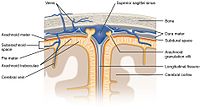
Photo from wikipedia
OBJECTIVE The aim of this study was to describe the processes and outcomes associated with patients at five sites in the Adult Hydrocephalus Clinical Research Network (AHCRN) who had undergone… Click to show full abstract
OBJECTIVE The aim of this study was to describe the processes and outcomes associated with patients at five sites in the Adult Hydrocephalus Clinical Research Network (AHCRN) who had undergone evaluation and treatment for suspected idiopathic normal pressure hydrocephalus (iNPH) and had 1-year postoperative follow-up. METHODS Subjects with possible iNPH who had been prospectively enrolled in the AHCRN registry between November 19, 2014, and December 31, 2018, were evaluated by CSF drainage via either lumbar puncture or external lumbar drainage, consistent with recommendations of the international iNPH guidelines. Standardized clinical evaluations of gait, cognition, urinary symptoms, depression, and functional outcomes were conducted at baseline, before and after CSF drainage, and at 4-month intervals after shunt surgery. Complications of CSF drainage and shunt surgery were recorded. RESULTS Seventy-four percent (424/570) of patients with possible iNPH had CSF drainage, and 46% of them (193/424) underwent shunt surgery. The mean change in gait velocity with CSF drainage was 0.18 m/sec in patients who underwent shunt surgery versus 0.08 m/sec in patients who did not. For shunt surgery patients, gait velocity increased by 54% from 0.67 m/sec before CSF drainage to 0.96 m/sec 8-12 months after surgery, and 80% of patients had an increase of at least 0.1 m/sec by the first postoperative visit. Evaluation of cognition, urinary symptoms, depression, and functional outcomes also revealed improvement after shunt surgery. Of 193 patients who had undergone shunt surgery, 176 (91%) had no complications and 17 (9%) had 28 complications. Eleven patients (6%) had 14 serious complications that resulted in the need for surgery or an extended hospital stay. The 30-day reoperation rate was 3%. CONCLUSIONS Using criteria recommended by the international iNPH guidelines, the authors found that evaluation and treatment of iNPH are safe and effective. Testing with CSF drainage and treatment with shunt surgery are associated with a high rate of sustained improvement and a low rate of complications for iNPH in the 1st year after shunt surgery. Patients who had undergone shunt surgery for iNPH experienced improvement in gait, cognitive function, bladder symptoms, depression, and functional outcome measures. Gait velocity, which is an easily measured, objective, continuous variable, should be used as a standard outcome measure to test a patient's response to CSF drainage and shunt surgery in iNPH.
Journal Title: Journal of neurosurgery
Year Published: 2022
Link to full text (if available)
Share on Social Media: Sign Up to like & get
recommendations!